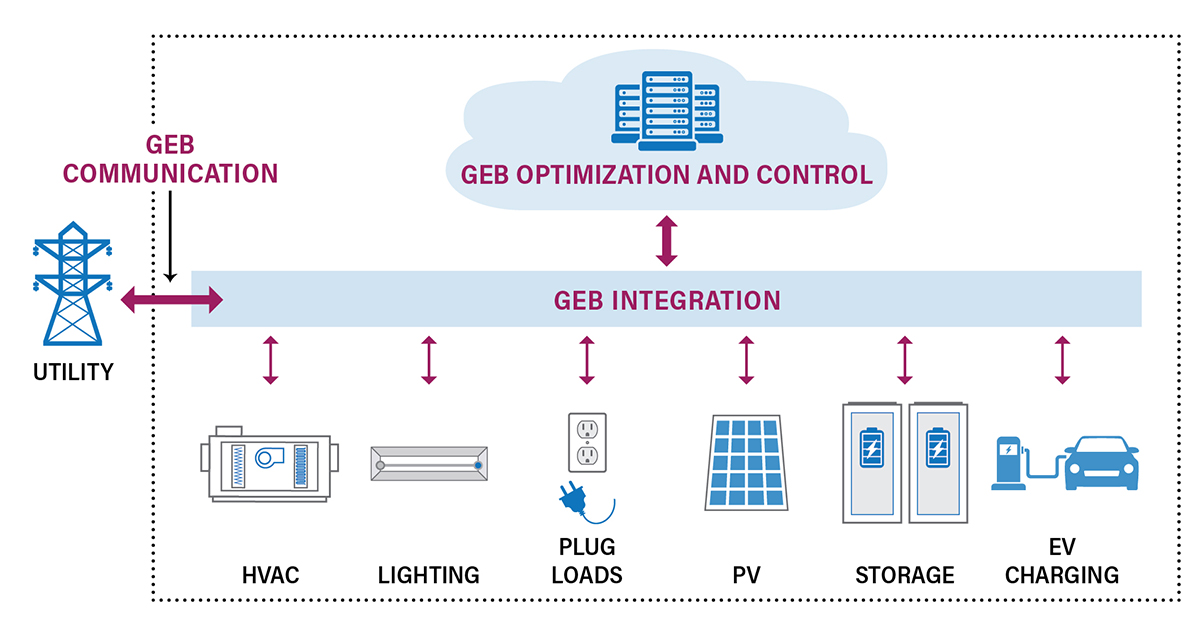
The Three Pillars of GEB Controls
Balancing energy supply and demand is the puzzle in front of utilities as renewables clean up the grid. The key lies in buildings that change when they use energy. Grid-interactive efficient buildings (GEBs) use smart building technologies and behind-the-meter distributed energy resources (DERs) to optimize energy use and power generation, unlocking a new way for buildings to interact with the grid.
GEBs play an important role in the transition to a decarbonized economy. Buildings account for more than 70% of U.S. electricity use and at least one third of CO2 emissions across the U.S. Transforming our buildings into GEBs not only reduces emissions. It also turns them into assets that helps utilities balance supply and demand.
Distributed Energy Resources: The key components of GEBs
The key components of GEBs are the small-scale units that consume or generate electricity locally within the building. These are known as distributed energy resources (DERs), which include:
- Equipment such as HVAC, plug loads, and lighting systems
- Thermal and battery energy storages
- Electric vehicle (EV) charging
- Solar photovoice (PV) inverters
- Onsite renewables such as wind turbines
These technologies work together to adjust how (and when) it uses energy or produces power.
However, a grid-interactive efficient building is more than just a collection of DERs. According to the Department of Energy’s definition, there are four main characteristics of a GEB.
GEB Attributes
| Efficient | Free of equipment and operational faults. The building runs smoothly while maintaining occupant comfort. |
|---|---|
| Connected | Enables two-way communication between technologies, the grid, and occupants. Can respond to time-dependent grid needs. |
| Smart | Supports advanced, optimal controls for buildings and community energy systems. |
| Flexible | Provides dynamic load control to support the electric grid, including shedding, shifting, and modulating loads. |
For building owners, GEBs can maximize value by taking advantage of utilities' demand response incentive programs. For utilities, GEBs can help balance power supply and demand and reduce the need to build more power plants—easing the variability challenges posed by the shift away from fossil fuels.
GEB Controls' three functions
To provide grid services, a GEB must have a control platform that makes it flexible. It accomplishes this with the three main pillars of GEB controls.
1. Integration
The GEB control platform needs to integrate multiple DERs to optimize and control them as a system. For example, a modern HVAC control system might use an open protocol such as BACnet or LonTalk, but the building’s networked lighting controls use a different protocol entirely. Different systems often have their own control software and communication standards. An integrated GEB control platform unites all these DER control systems, allowing them to exchange information and control the building in harmony.
2. Communication
For GEBs to provide service to the grid, the GEB control platform needs to know when—and by how much—the grid needs a building to shed, shift, and modulate its energy load to meet (or reduce) demand. Crucially, this communication goes both ways. The actual building power data will be sent back to the utility, allowing it to verify the changes in demand and even potentially adjust its electricity rates on the fly.
3. Optimization and Control
The “brain” of the GEB control platform is its algorithm that makes decisions for the good of the building and the grid. The algorithm takes in information from the building’s systems—as well as the grid—and adjusts its energy use on the fly. A building might have different goals at any given time. For instance, it might want to:
- Take advantage of dynamic utility rates
- Reduce energy use at peak demand
- Run at minimal carbon emissions
Whatever a GEB might want to achieve, how it makes the decisions is based on complex mathematical optimization problems. It uses variables such as available information, system constraints, and current objectives.
Remember, though, that there is two-way communication. Utilities can also adjust their incentive rate structures and automated demand response events to inform a GEB's decisions so that the entire system is always at an optimal (or near-optimal) state.
Grid-interactive efficient buildings—and the controls that make them function—are still an emerging technology. The building industry faces many technical and non-technical challenges and barriers to widespread GEB adoption. Slipstream is actively working in these areas to demonstrate the viability of GEBs and prove their value to both building owners and utilities. Our projects currently include demonstrations of GEB concepts throughout the Midwest—including using our own headquarters in Madison as a test bed.